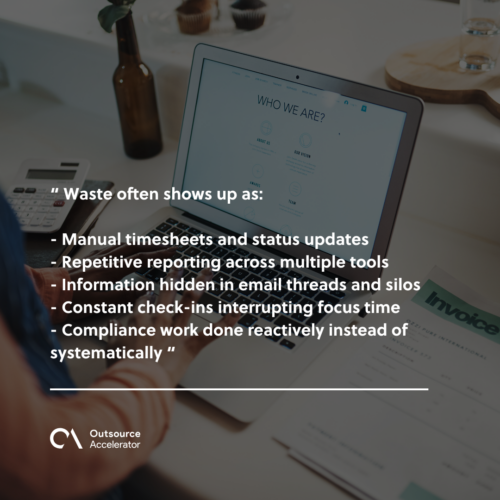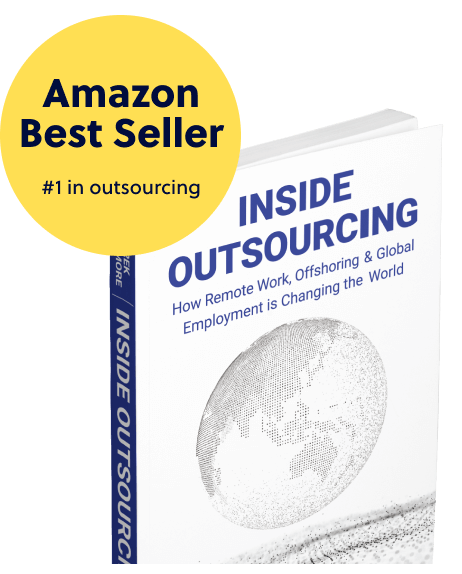How lean workflows boost BPO productivity without adding headcount

The new operational mantra in the BPO world is simple: scale smarter, not heavier.
For too long, outsourcing growth was a simple math problem—more people, bigger facilities. But today’s elite BPOs have flipped the script.
They’re crushing productivity goals, boosting delivery outcomes, and protecting margins not by throwing headcount at the problem, but by getting lean. They’re eliminating busywork, automating operations, and trusting their teams to focus on high-impact work.
According to Hubstaff’s 2025 Lean Advantage Playbook, the next decade belongs to organizations that master leverage: less effort for significantly more output.
Productivity is no longer about filling the schedule; it’s about engineering it into the system itself. Lean workflows are the ultimate competitive weapon.
The concept of lean workflows
Lean workflows focus on removing waste, especially the tasks that consume attention but produce little value.
In BPO environments, that “waste” often shows up as:
- Manual timesheets and status updates
- Repetitive reporting across multiple tools
- Information hidden in email threads and silos
- Constant check-ins interrupting focus time
- Compliance work done reactively instead of systematically

Instead of designing processes around who does the work, lean workflows optimize how work flows through the system.
The report warns that the biggest productivity threat BPO teams face is not talent shortages; it’s the manual tasks holding high performers back. Lean workflows eliminate that drag.
One powerful example comes from Hubstaff data: AI usage alone gave employees 30 more minutes of productive time daily because they stayed in the flow longer without mental blockers. That kind of daily momentum creates operational breakthroughs.
Lean workflows are built on three core principles:
- Remove friction
- Enable focus and flow
- Make performance visible without micromanaging
When work moves better, people perform better. And when people perform better, productivity compounds.
Key benefits of lean workflows in BPO
Lean workflows provide a multi-layered productivity boost with benefits that reach far beyond simply “working faster.”
Some key advantages include:
1. Major productivity gains from small daily wins
A 30-minute improvement per person per day might seem minor. But the report shows how these minutes add up:
- 500 hours saved monthly for a 50-person team
- 6,000 hours saved yearly
- $150,000 in reclaimed productivity at $25/hour
That extra half hour of regained focus per person can be the difference between rushing to meet deadlines and staying ahead of them. It also helps teams maintain consistent performance across fluctuating workloads, which matters deeply in high-volume BPO environments.

Research by the U.S. Bureau of Labor Statistics found that the growth in remote work across industries between 2019 and 2022 was positively associated with total factor productivity (TFP) growth.
Essentially, as more work shifted remotely, industries saw measurable productivity gains — a powerful validation of the impact lean, focused workflows and flexible work arrangements have on boosting output without increasing headcount.
The result is a steady rise in productivity without needing more hands on deck.
2. A stronger customer delivery engine
When teams are not buried under admin, they:
- Resolve tickets faster
- Deliver work with fewer errors
- Spend more time on client-facing priorities
When agents spend less time in spreadsheets and more time solving human problems, customer satisfaction naturally climbs. Lean workflows help reduce support backlogs and prevent quality dips during peak seasons.
Instead of firefighting, teams can proactively elevate the client experience.
3. Operational clarity without the chaos
The report notes a growing challenge: employees resist sharing workflows because it exposes inefficiencies. Transparency becomes the real risk in remote work.
Lean workflows provide real-time visibility through:
- Automated dashboards
- Smart notifications
- Passive monitoring of work progress
This creates accountability without constant interruptions.
As Hubstaff’s CEO Jared Brown says:
“We don’t require AI fluency, but we look for curiosity and willingness to experiment. That’s non-negotiable.”
Curiosity thrives when visibility is effortless, not burdensome.
Clear visibility eliminates guesswork, letting both leaders and contributors make better decisions faster.
Lean workflows also reduce “status anxiety,” where employees feel pressured to constantly update their managers. It builds trust, because accountability is built into the system, not demanded through interruptions.
4. Compliance becomes scalable and stress-free
85% of workers say they use AI tools, but only 4% of their time reflects this in productivity data, raising security and privacy concerns for BPOs that work across borders and regulations.
Lean compliance workflows help teams:
- Automate time and payroll accuracy
- Meet local labor rules automatically
- Easily generate audit-ready information
Automated checks and standardized recordkeeping reduce costly compliance mistakes that often surface too late. Teams no longer have to scramble for documentation during audits, and managers gain confidence in their operational integrity.
This creates a strong foundation for expanding into new markets or adding new client accounts.
5. Lean workflows reduce burnout and boost morale
In the US, employee engagement fell in 2024 to only 31% of employees engaged, the lowest in a decade, according to Gallup.
When people don’t spend half their day wrestling with process friction, they:
- Feel more supported
- Take ownership of their work
- Stay longer with the organization
Removing tedious manual work gives employees more cognitive space for meaningful tasks, which improves job satisfaction.
Retention improves when workflows respect human energy. When teams feel productive and supported instead of overloaded, engagement rises and turnover drops.
That stability becomes a performance advantage for every client relationship.
How BPOs design lean workflows that scale
Lean workflows aren’t built overnight. They evolve intentionally through targeted improvements that accumulate and compound.
The Playbook recommends adopting workflow shifts in structured phases designed to produce quick, visible ROI.
Here’s how leading BPOs make that happen:
A. Automate the low-value tasks first
A Zapier report on automation found that 94% of companies perform repetitive, time-consuming tasks. Automation improved jobs for 90% of knowledge workers and increased productivity for 66% of them.
Automation tackles the repetitive, error-prone admin work that slows teams down:
- Manual time entry becomes automated time tracking
- Weekly progress updates become scheduled reports
- HR form collection becomes digitally centralized
- Payroll prep becomes integrated directly with tracked hours
The report notes that leaders should audit workflows for clarity first, since lack of clarity is the most common barrier to automation adoption (48%). By removing tedious manual friction, employees contribute more to billable and client-facing work instead of clerical overhead.
B. Standardize success using SOPs
Without documented workflows, quality varies and scaling creates chaos.
Lean-forward BPOs scale what already works by:
- Collecting best practices from top performers
- Turning those practices into repeatable systems
- Making them accessible org-wide through knowledge tools
The Playbook cites a BPO that expanded internationally while maintaining delivery standards by embedding standardized workflows from day one, reducing complexity and increasing profitability across regions.
C. Empower asynchronous collaboration
Meetings often drain productivity faster than any other activity.
Lean workflows support async work by:
- Using dashboards to show progress instantly
- Replacing check-in calls with automated updates
- Giving autonomy to global teams operating in different time zones
This approach supports more deep work, faster decisions, and fewer communication bottlenecks. The result is a more fluid, always-moving delivery pipeline.
D. Make compliance part of the workflow design
When compliance is integrated, not tacked on, it becomes safer and simpler for everyone.
Lean compliance workflows:
- Trigger alerts for missing time entries or rule violations
- Track AI tool usage to prevent privacy risks
- Maintain location-based access control
- Generate audit-ready reports instantly
The Playbook highlights that aligning Hubstaff with an EOR platform led to faster onboarding and fewer payroll errors, reducing disruptions and strengthening client trust.
E. Stack improvements into continuous operational gains
High-performing BPOs focus on incremental wins, not giant transformations.
A 30-day roadmap in the Playbook breaks it down:
Week 1: Assess where time and money are wasted
Week 2: Remove one major bottleneck
Week 3: Automate reporting and visibility
Week 4: Turn the improvements into new benchmarks
Those improvements quickly become self-reinforcing systems that scale effortlessly as the business grows.

The future of BPO productivity is lean
The old model of “hire more to deliver more” is no longer viable. Budgets are tight. Talent markets fluctuate. And clients expect continuous optimization rather than incremental improvements.
Lean workflows in BPO operations empower leaders to:
- Improve output with existing headcount
- Increase delivery consistency and speed
- Strengthen margins without limiting growth
- Build transparency into every part of the operation
- Protect teams from burnout while enhancing engagement
As the Playbook emphasizes, operational excellence is now achieved by stacking small wins that compound into massive performance gains over time.
That’s why BPOs that embrace lean principles today are becoming the agility leaders of tomorrow, adapting faster to new technologies and client expectations.
Lean workflows don’t shrink the role of people.
They elevate it.
By cutting out waste and letting talent shine, BPOs unlock the truest advantage: teams who feel empowered and equipped to deliver their best work every day.
The future of BPO isn’t about working harder. It’s about working leaner, smarter, and with purpose.
Download Hubstaff’s Lean Advantage Playbook for BPOs and Virtual Teams to learn more.







 Independent
Independent




